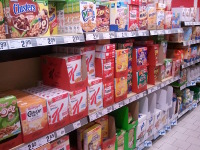
Recently I've been traveling in Europe, which explains the lack of blog posts here.
Of course, regardless of where I go I am always interested to discover what I can about cereal in that location. And, Europe is a great place to observe a different take on cereal. It's been a number of years since I've had the opportunity to visit there, and I was pleasantly surprised with the changes I noticed.
First, the interest in cereal is definitely growing. Certainly, breakfast cereal consumption is nowhere near what it is in North American, but it is no longer an ethnic food for ex-pats. Evidence of this abounds in the grocery stores. Whereas at one time on the continent you would have seen very small shelf space devoted to just a handful of cereal brands, now it is possible to enter any supermarket and see a significant section featuring dozens of varieties. I also noticed that at some of the bed and breakfast places we stayed cereal was available, something I never saw before outside of big hotels catering to international travelers.
It was also evident that that there are some differences between cereal in Europe and the U.S. Even those who do consume it tend to eat smaller serving sizes, and as a complement to their traditional breakfast. For this reason the boxes for sale in the stores are much smaller than what we would typically find in North America. Also, muesli is big in Europe influenced by its popularity in Switzerland, where it is often still consumed during the evening meal.

I also noticed some interesting innovations in Europe. Not only are the big cereal companies tweaking their recipes and producing varieties in tune with the local preferences, but there are packaging innovations as well. In Poland, for example, I couldn't find any actual boxes. All the cereal comes in attractive bags. There are other signs of innovation in Europe as well, as is evidenced by the fact that customized cereal has its roots there with such companies as
mymuesli and
The Cereal Club.
Having said of all this, I must qualify the above statements by pointing out that the United Kingdom stands out in its relationship with cereal. While I wasn't there on this trip, it is a fact that cereal consumption is much higher in Britain than the rest of Europe, and has many more similarities to its U.S. brand counterparts.
I had a great time in Europe, and enjoyed the cereal sleuthing that went along with it!
 Halloween and cereal are a perfect fit, and a number of companies have taken advantage of the marketing opportunities over the years, and none more than General Mills. Again, this year, they released their monster cereals in time for Halloween, but they were largely unchanged in box design from 2010. Several other children's-oriented cereals feature similar seasonal graphics again this year.
Halloween and cereal are a perfect fit, and a number of companies have taken advantage of the marketing opportunities over the years, and none more than General Mills. Again, this year, they released their monster cereals in time for Halloween, but they were largely unchanged in box design from 2010. Several other children's-oriented cereals feature similar seasonal graphics again this year.  Recently, a study from
Recently, a study from  A
A  Last week
Last week  Recently I've been traveling in Europe, which explains the lack of blog posts here.
Recently I've been traveling in Europe, which explains the lack of blog posts here. I also noticed some interesting innovations in Europe. Not only are the big cereal companies tweaking their recipes and producing varieties in tune with the local preferences, but there are packaging innovations as well. In Poland, for example, I couldn't find any actual boxes. All the cereal comes in attractive bags. There are other signs of innovation in Europe as well, as is evidenced by the fact that customized cereal has its roots there with such companies as
I also noticed some interesting innovations in Europe. Not only are the big cereal companies tweaking their recipes and producing varieties in tune with the local preferences, but there are packaging innovations as well. In Poland, for example, I couldn't find any actual boxes. All the cereal comes in attractive bags. There are other signs of innovation in Europe as well, as is evidenced by the fact that customized cereal has its roots there with such companies as 